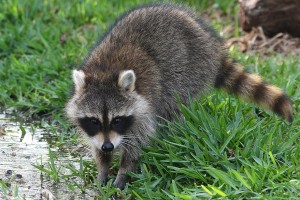
Raccoon
Appearance
Black ‘mask’ around the eyes, bushy striped tail
Color
Grey with black and white features
Size
16-28 inches long with an 8-16 inches tail, 9-12 inches tall and 4-30 pounds.
Habitat
Raccoons are usually found in wooded areas because they need vertical structures (trees) to climb when they are threatened
Interesting Facts
Raccoons have incredible memories, recalling solutions to certain tasks, paths and food opportunities for up to three years
About the Raccoon
The raccoon is a medium sized mammal native to North America. Easily distinguishable by the ‘mask’ of black fur around its eyes, the raccoon is a very intelligent animal that has adapted itself to live in many different environments. Some of those environments happen to be around people, and in many areas it has become known as a pest.
With the raccoons increasing in urban populations, interactions with humans have increased over recent years. Experts also believe that large numbers of people feeding the raccoons in city/urban areas has increased their numbers as well. Because of this, as well as their long life span (they can live for up to 20 years), they have become a nuisance to many business owners.
Raccoon Control
Raccoons are considered pests for several reasons. They are carriers of the disease rabies, which they can spread to humans. They also make dens in attics and crawlspaces and often do thousands of dollars in damage.
If you have a pest raccoon, your best option is to call a professional, especially because killing or relocating a raccoon may be illegal in your city.
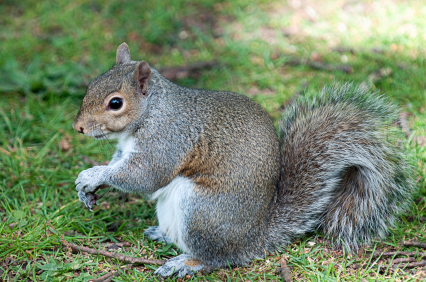
Tree Squirrel
Appearance
Medium sized rodent with a bushy tail
Color
Gray possibly with a brownish-reddish tint and white underside
Size
9-12 inches with a 7-10 inch-long tail weighing 14-21 ounces
Habitat
Usually in large areas of woodland or wooded urban areas
Interesting Facts
While most tree squirrels are grayish in color, they can also be solid black or white
About the Tree Squirrel
Tree squirrels comprise an entire grouping of squirrels that includes up to 180 species. In North America, especially the east coast, the most common species is the Eastern gray squirrel. It can be found from the southeastern United States all the way into Canada and as far west as Texas.
While they usually live in wooded areas, they have also made themselves at home in urban areas that have trees. They are usually harmless but squirrels can become quite troublesome when living around humans.
Tree Squirrel Control
Tree squirrels tend to nest in attics and walls and can cause serious damage. They have also been known to gnaw on electrical wires when making their dens in structures. The best prevention methods are similar to other rodents; sealing any entrances to the dwelling.
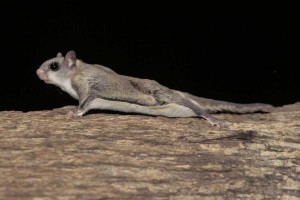
Flying Squirrel
Appearance
Large eyes and a furry, flattened tail; ‘wings’ between their front and rear legs
Color
Grayish brown on top with a cream colored/white underbelly
Size
8-10 inches long and around 1.5-3 ounces
Habitat
They prefer forests with large populations of hickory and beech trees, but they are also found in human habitats
Interesting Facts
The flying squirrel can’t actually fly; it uses its ‘wings’ only to glide from tree to tree
About the Flying Squirrel
Flying squirrels are one of the more interesting species of rodents. While they can’t actually fly, they do use their ‘wings’ to glide quickly from tree to tree. They are surprisingly graceful in flight, weaving between objects at will if needed. The membrane between their front and back legs cause them to be clumsy on their feet.
Flying squirrels don’t usually find themselves in densely populated areas but they can present problems when around humans. They almost always reside in naturally occurring shelters such as holes or woodpecker holes, but they will also make themselves at home in attics, causing damage.
Flying Squirrel Control
The best way to get rid of a flying squirrel problem is to contact a Wildlife Control Specialist as soon as possible. They can carry diseases and are difficult to catch.
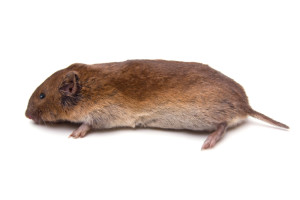
Vole
Appearance
Similar to a mouse but with a stouter body and tail
Color
Grayish brown on top with a cream colored/white underbelly
Size
3-9 inches long
Habitat
Voles are burrowers, so they are usually found in tunnels and burrows under vegetation
Interesting Facts
Voles have an extremely short gestation period and could have up to 10 litters of young in a year (if they lived that long)
About the Vole
Voles are small rodents that are very similar looking to the common house mouse. There are upwards of 155 species of voles, all of which are burrowing animals. Voles are very short-lived animals, rarely making it to a year old. They make up for this by becoming sexually mature at a very young age and having a very short gestation period.
Voles become pests when they find themselves burrowing under human crops and other vegetation. They will attack crops of all types including fruits and vegetables. Turf and grass can also come under the fire of voles, especially at sporting fields and golf courses. Trees and bushes can even be at risk when the voles chew their roots.
Vole Control
There are a variety of methods to control and prevent voles. To get rid of an existing population of voles you should contact a Wildlife Control Specialist.
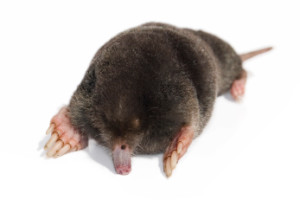
Mole
Appearance
A small, fat rodent with enlarged front paws for digging
Color
Range of browns and taupe colors, sometimes appearing black
Size
5-6 inches long
Habitat
Moles are burrowers, so they are usually found in tunnels and burrows under vegetation
Interesting Facts
Moles can eat up to 100% of their body weight in food in a single day
About the Mole
Moles are found all over the continental United States. They prefer areas with little tree coverage because the roots interfere with their burrowing, so they are most often found in fields, pastures, meadows and large yards. Since they spend almost their entire lives underground, they are almost blind and their eyes can hardly differentiate between light and dark.
Moles can actually be beneficial to the soil they dig through because their burrows aerate the soil and help get moisture deeper in the ground. However, when they burrow under grass in landscaped lawns it will often kill the grass on top of the burrow, so they become pests.
Their burrows can also cause structural damage and disrupt landscape features.
Mole Control
Every mole treatment is unique to the area needing treatment. There are numerous methods available, including mechanical and application of deterrents. Call a professional for a thorough evaluation of your pest problem and to learn more about your remediation options.
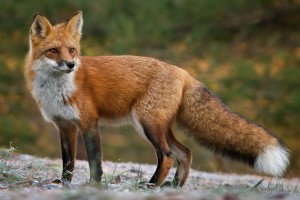
Fox
Appearance
Small to medium sized animal similar to dogs with a bushy tail
Color
From reddish/orange to brown, grey, and white
Size
14-20 inches tall at the shoulder, they vary greatly in weight from 4-31 pounds.
Habitat
Most of North America other than the southwest/west coast; they are very adaptable animals and can be found in dense woods, deserts or urban environments
Interesting Facts
The red fox has the largest range of any species in the order Carnivora, which includes bears, cats, canines and wolverines
About the Fox
Foxes can be found throughout most of the United States in almost every type of environment. Foxes can make themselves at home in almost any situation, whether it’s hunting for its own food in the woods or stealing trash in the city.
Foxes have been hunted for thousands of years and have been considered a pest animal throughout most of that time. They carry a wide variety of diseases and parasites, including rabies. They will also kill livestock, especially chickens, and have also been known to kill some smaller domesticated animals.
Fox Control
The best methods to rid an area of pests are trapping or hunting, but there are also alternative methods that can be used.
The many risks involved with handling foxes means you should call a wildlife control specialist.
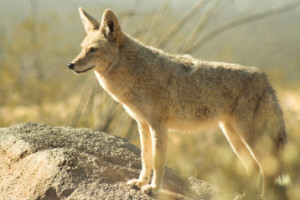
Coyote
Appearance
Very similar to a wolf but with a slimmer muzzle and smaller size
Color
Grayish-brown and reddish-brown to light gray and white
Size
23-26 inches at the shoulder, 15-46 pounds in weight
Habitat
Most of North America
Interesting Facts
Coyotes have been known to mate with both domestic dogs and wolves, creating the hybrids Coydogs and Coywolves
About the Coyote
Coyotes generally travel in packs but may also hunt alone or in pairs. They usually avoid contact with humans by being primarily nocturnal and staying out of the way in their burrows. Coyotes are omnivores with a diet consisting of small, game-like squirrels, mice and birds, as well as bigger animals like livestock and deer. They will also eat fruits and vegetables when they are available in the warmer months.
While coyotes have proved themselves better able to coincide with humans than wolves, they still have their share of human interaction problems. They will kill and eat cats and smaller dogs, as well as livestock in agricultural settings.
Coyote Control
Coyotes are most often seen as pests because in rural areas they often attack and kill livestock, including cows, pigs and sheep. Farmers, as well as the US government, kill around 90,000 animals a year to protect livestock.
If you see a coyote in your area, especially during the daylight areas, do not attempt to manage the situation yourself.
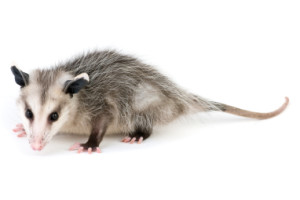
Opossum
Appearance
Marsupial about the size of a housecat with a hairless tail
Color
Gray to white body fur, usually with a white head and black ears
Size
Varies greatly, from 13-37 inches long and from 2-14 pounds in weight
Habitat
Most of North America
Interesting Facts
The Virginia Opossum is the only marsupial native to North America
About the Opossum
Opossums are an extremely adaptable species, and because of this, they live in a very wide range of environments. Their range extends from the east coast all the way west to the Rockies and south to Panama. They are comfortable living in both rural and urban settings and have a history of human interaction, especially in the southeast.
The opossum is known for ‘playing dead’ or ‘playing opossum’. When they find themselves threatened or in danger, they will simply lie down and pretend to be dead. Scientists now believe that this reaction is completely involuntary and triggered by fear. Opossums will also display aggression when it awakes if the threat is still there.
Opossum Control
In urban areas opossums quickly become pests, eating pet food and getting into garbage cans and trash. There are a variety of wildlife control methods to address opossum problems.
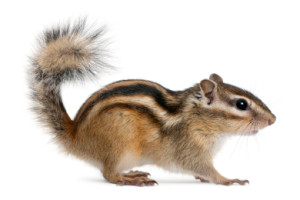
Chipmunk
Appearance
Small striped rodents
Color
Reddish brown fur with 5 dark stripes and lighter fur on the lower body
Size
4-7 inches long with a weight of 1-5 ounces
Habitat
Wooded areas and urban parks
Interesting Facts
When building its burrow, chipmunks will carry the dirt far away so it doesn’t draw attention to its home
About the Chipmunk
Chipmunks are solitary creatures outside of mating season. They spend most of their time defending their burrows and collecting food in the trees, as well as what they can find on the ground.
The reason chipmunks are considered pests is that their burrows can cause damage to human structures. They have been known to tear up patios, pools, stairs, retaining walls and other landscaping features. They are also notorious pet and bird food thieves.
Chipmunk Control
As is the case with most rodents, efforts to prevent the chipmunks from entering your property are the best option. By keeping your landscaping free of debris and ground covering and keeping food sources such as pet and bird food out of reach will help to keep chipmunk numbers down.
If you already have a problem there are several pest control methods and materials that may be used to trap or eradicate the pests.
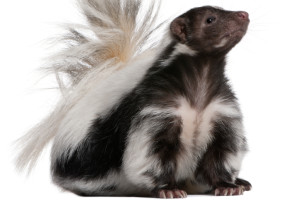
Skunk
Appearance
Medium sized mammal with long hair and two white stripes down its back
Color
Black or dark brown with white/cream stripes
Size
Vary in size from 15-36 inches long and 1-18 pounds.
Habitat
Most of North America
Interesting Facts
Skunks are one of the honeybee’s primary predators
About the Skunk
Skunks can be found throughout most of North America, excluding extremely arid areas in the southwest. They are most known for their method of defense, which involves spraying a very odorous liquid at its attackers. They are also omnivorous and highly adaptable, which is why they can be found in such a large range.
Skunks usually try to avoid humans, but they will venture indoors looking for food. They will seek out garbage cans and will also eat any pet food found in garages or accessible basements.
Skunk Control
If you find a skunk on your property the best course of action is to contact a professional. They can be vectors of disease, and their defensive liquid is very potent.









